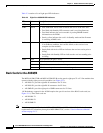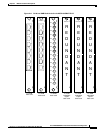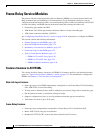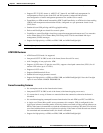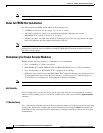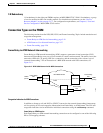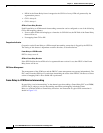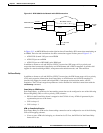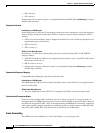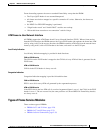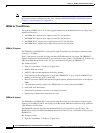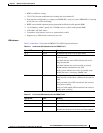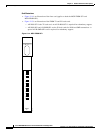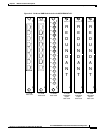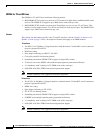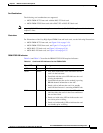
2-26
Cisco MGX 8850 Multiservice Switch Installation and Configuration
Release 1.1.31, Part Number 78-11223-03 Rev. B0, May 2005
Chapter 2 Module and Service Descriptions
Frame Relay Service Modules
• DE is always 0.
• DE is always 1.
Setting up the cell loss priority option is accomplished through the MGX 8850 cnfchanmap (configure
channel map) command.
Congestion Indication
Frame Relay–to–ATM Direction
Each Frame Relay-to-ATM service interworking connection can be configured as one of the following
Forward Explicit Congestion Notification (FECN) to Explicit-Forward Congestion Indicator (EFCI)
schemes:
• FECN bit in the Frame Relay frame is mapped to the EFCI bit of every ATM cell generated by the
segmentation process of the frame.
• EFCI is always 0.
• EFCI is always 1.
ATM–to–Frame Relay Direction
Frame Relay– to–ATM service interworking connections use the following EFCI to FECN/BECN
mapping schemes:
• If the EFCI bit in the last ATM cell of a segmented frame received is set to 1, the FECN of the Frame
Relay frame will be set to 1.
• BECN is always set to 0.
• Setting up the congestion indication option is accomplished through the cnfchanmap (configure
channel map) command.
Command and Response Mapping
Command/Response Mapping is provided in both directions.
Frame Relay–to–ATM Direction
The FRSM maps the C/R bit of the received Frame Relay frame to the CPCS-UU least-significant bit of
the AAL5 CPCS PDU.
ATM to Frame Relay Direction
• The least-significant bit of the CPCS-UU is mapped to the C/R bit of the Frame Relay frame.
Translation and Transparent Modes
Each service interworking (SIW) connection can exist in either translation or transparent mode. In
translation mode, the FRSM translates protocols between the FR NLPID encapsulation (RFC 1490) and
the ATM LCC encapsulation (RFC 1483). In transparent mode, the FRSM does not translate. Translation
mode support includes address resolution by transforming address resolution protocol (ARP, RFC 826)
and inverse ARP (inARP, RFC 1293) between the Frame Relay and ATM formats.
Frame Forwarding
The FRSM card can be configured as “Frame Forwarding” on a port-by-port basis.



